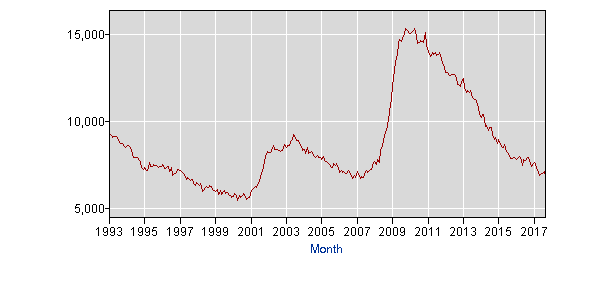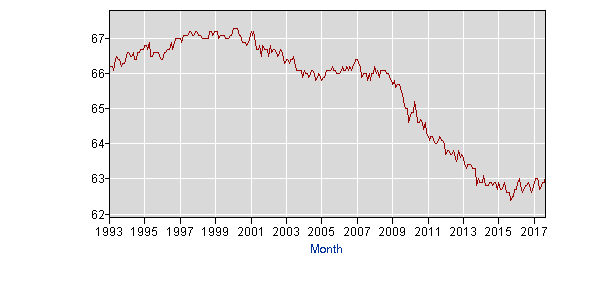Unemployment
The major problem of economic recessions and depressions is high unemployment. When unemployment is severe or prolonged, it can lead to social disintegration, loss of job skills, and increased difficulty of finding a new job. It can also cause social unrest because more people fall into poverty. However, not everyone who is not working is considered unemployed — only those who are part of the labor force, those who are actively seeking employment.
Labor Force
The total population of any economy is divided into 4 major sections, in regards to employment:
- Those under 16 or institutionalized are not considered part of the labor force and are not eligible to seek employment.
- Those able to work but are not in the labor force, because they are not seeking employment, such as homemakers, full-time students, and retirees.
- Almost half of the population that is employed.
- The small number of people who are unemployed, which are those able to work and are actively seeking employment.
Discouraged workers are also not included in the labor force, because, although they would like work, they have given up looking for it.
The labor force consists of all people who are either employed or unemployed but seeking work.
| Number of Unemployed | ||||
| Unemployment Rate | = | ÷ | × | 100 |
| Number in Labor Force |
In the United States, the unemployment rate is determined by the Bureau of Labor Statistics (BLS), which conducts a monthly nationwide random survey of about 140,000 businesses and government agencies, representing approximately 440,000 individual worksites, providing detailed industry data on nonfarm employment, hours, and earnings of workers. The results of this sampling are then projected to the entire nation.

However, economists have criticized the BLS statistics because it counts part-time employment as full employment, even if the workers are seeking full-time employment. Also, the BLS only counts people actively seeking work, but, especially in recessions, many people would like to work but are discouraged enough to stop seeking employment. Hence, the actual unemployment rate usually exceeds what the BLS statistics suggest.
The BLS also determines the labor force participation rate from the same survey, which is the percentage of adults in the labor force:
| Number in Labor Force | ||||
| Labor-Force Participation Rate | = | ÷ | × | 100 |
| Number of Adults |

Types of Unemployment
Unemployment is generally classified into 3 types, according to the cause of unemployment: frictional, structural, and cyclical.
Frictional unemployment is the unemployment that results when people are between jobs or when they first start looking for jobs. Many people quit or get fired from their job, causing them to be unemployed temporarily. Although most people looking for work eventually find another job, there are always others who lose their job for one reason or another, and so become part of the unemployment pool. Because this happens continually, frictional unemployment is persistent, and represents the minimum that the unemployment rate can go.
Structural unemployment results when there is a mismatch between the skills demanded by employers and the skills that workers have. Structural unemployment may also result from the relocation of jobs to different geographical areas, because many people tend to remain where they have lived most of their lives. Structural unemployment can persist over many months or even a few years, until people can retrain or develop new skills or they become willing to relocate in new areas where there are jobs.
Structural unemployment may also arise because of licensing requirements imposed by governments. Licensing requirements are generally used to ensure that workers are competent in their profession, especially when incompetency can hurt consumers significantly, such as with lawyers and doctors. However, there are also many professions that do not require extensive training, such as hairdressers and barbers, that, nonetheless, require licensing in many jurisdictions. The primary reason for imposing these licensing restrictions is so the government can collect revenue from licensing fees. Members of the profession also favor licensing because it restricts the supply of labor in that profession, thereby allowing those who can find jobs to earn higher wages. But the higher wages come at a cost of increased unemployment or underemployment.
Cyclical unemployment results from the decreased aggregate expenditures by the economy during a recession, when businesses have cut back on their production of output. Since labor is an input, reduced output lowers the demand for labor. Hence this type of unemployment is sometimes called deficient-demand unemployment. For instance, during the Great Recession from 2007 to 2010, the unemployment rate in United States hovered slightly under 10%.
Full Employment
The economy is considered at full employment when the unemployment rate equals the economy's natural rate of unemployment, which is also when economic output is at a maximum. Thus, full employment is a desirable goal.
Because frictional and structural unemployment are part of any economy, true, full employment, where everyone in the labor force has a job, does not occur. Instead, economists talk about a natural rate of unemployment (NRU), which is the absence of cyclical unemployment, but not frictional or structural unemployment. In other words, the unemployment rate will rarely drop below the natural rate of unemployment. Generally, when there is a natural rate of unemployment, the number of job vacancies equals the number of job seekers. Sometimes, however, the unemployment rate can drop a little below the natural unemployment rate, because demand for labor is so high, that even workers who were not actually looking for a job may be enticed by higher wages and the ready availability of jobs.
Determinants of the Natural Rate of Unemployment
The natural rate of unemployment has come down over the years, largely due to improvements in technology. The Internet, for instance, allows employers to post available jobs for little or no cost, or they can search resumes online to find people with the appropriate skills. People looking for jobs also have it much easier, since they can search for jobs on their own home computers.
However, the natural rate of unemployment is often higher than it would otherwise be, because of certain laws that support a higher rate. For instance, the natural rate of unemployment differs among nations. France, Germany, and the United Kingdom generally have higher unemployment rates than the United States, because they have more generous unemployment benefits, which lessen the need to find a new job, and because employers are reluctant to hire because of the strict labor laws in Europe.
Thus, these countries increase the natural rate of unemployment with their own laws. The natural remedy is to change the laws so that economic output is maximized. This would include making unemployment benefits less generous and making it easier to fire unproductive workers.
Another method that can reduce the natural rate of unemployment is to reduce or eliminate excessive licensing requirements, and by restricting educational requirements to what is needed to do the job effectively. In the United States, for instance, many professions that don't require a lot of training, such as cutting hair, seek to establish a minimum training and licensing requirements, to raise the barriers of entry to the profession, to lessen potential competition. Likewise, colleges and other schools often require the study of general subjects with little value for the student's major, thus lengthening the time students stay in school, which makes them less productive overall, since they work less over their lifetime.
Structural unemployment exists because there is a mismatch between the skills that jobseekers have and the skills that employers are seeking. By reducing educational requirements to those required for proficiency in the profession, the amount of time to acquire these skills is reduced. This allows jobseekers to retrain at a minimum cost in time and money, which reduces structural unemployment, a major component of the natural rate of unemployment.
Another way to reduce the natural rate of unemployment is to increase competition among businesses. Monopolies and oligopolies produce less output, to limit supply and increase prices. This also means that these firms employ fewer people than would otherwise be the case in a more competitive environment. Additionally, higher prices reduce aggregate demand, which also increases the natural rate of unemployment.
Unemployment Hysteresis
If cyclical unemployment persists, then it may increase the natural rate of unemployment, by increasing structural or frictional unemployment, an effect known as unemployment hysteresis. For instance, the longer that a worker is unemployed, the more difficult it will be to find new employment, because some work skills may become obsolete and the worker may become less disciplined, or the worker may be discouraged from seeking new employment. Additionally, employers may have a negative view of the worker, because it took so long to find work, which may indicate a lack of motivation, resilience, or know-how. Unemployment hysteresis can be minimized through job-training and by teaching skills for finding and keeping a job.
Economic Cost of Unemployment
Unemployment above the natural rate means that the economy is producing less than its potential output, called the GDP output gap, or simply the GDP gap. Higher unemployment rates create larger GDP output gaps.
The size of the output gap created by a specific amount of unemployment was first quantified by the economist Arthur Okun and has, since, become known as Okun's Law. Okun's Law indicates that for every 1% of unemployment above the natural unemployment rate creates a GDP output gap of about 2%. So for a $10 trillion economy, a 1% unemployment rate above the natural rate of unemployment creates a $200 billion output gap. In the United States, the unemployment rate averaged 9.6% in 2010, which is about 5% above the natural unemployment rate. Since the United States had a nominal GDP of about $14.5 trillion, the high unemployment rate according to Okun's Law equals an almost $1.5 trillion output gap, which the government could have used to buy many goods and services, or it could have reduced taxes.
Generally, unemployment rates are higher for people with fewer skills or for people working in lower skilled occupations. Lower skilled workers are also less likely to be self-employed. Teenagers generally have higher unemployment rates because they have lower skill levels, frequently quit their jobs or get fired, and have less geographic mobility than adults. Blacks and Hispanics also suffer a higher unemployment rate than whites because more of them have less education, and are more concentrated in lower skilled occupations. Discrimination also increases the rate of unemployment. People with higher education normally experience lower unemployment rates.